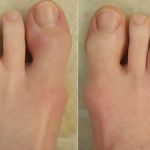If the patient’s symptoms are more inflammatory in nature, Dr. Mease will obtain a C-reactive protein (CRP) and/or sedimentation rate, along with possibly an X-ray, ultrasound or magnetic resonance imaging (MRI) assessment.
He also provides feedback to the referring dermatologist.
“Every time you see such a patient, it’s an educational opportunity to advance the understanding of the referring dermatologist about what are the key features of either generalized PsA or components of it, such as axial PsA,” Dr. Mease said.
Enthesitis & Inflammation
Dr. Hausmann asked how to determine when enthesitis is inflammatory, considering that conditions, such as Achilles tendinopathy, are common. One distinguishing factor is if significant trauma has occurred before the onset of an Achilles tendon problem, which could be an alternative explanation for the pain.
“Oftentimes, patients with inflammatory enthesitis will not be able to describe a specific incident, like going hiking with too heavy a backpack or something like that as the etiology of their Achilles or plantar fascia or patellar enthesitis. So it may be spontaneous,” Dr. Mease said.
Another clue is duration. In comparison with symptoms that last for a couple of weeks and that reasonably respond to anti-inflammatory medications, inflammatory enthesitis will endure a lot longer. To distinguish inflammatory enthesitis from traumatic enthesopathy or fibromyalgic enthesalgia, ultrasound or event MRI may be helpful, according to Dr. Mease.
If it’s chest pain, MRI and ultrasound will not be helpful. Instead, Dr. Mease uses a diagnostic Medrol Dosepak.
“If the chest pain just melts away, I have a stronger idea that this could be an inflammatory enthesopathy involving the ligaments of the ribs as opposed to a cracked rib or a mechanical-type costochondral problem,” he said.
Choosing a Treatment
With so many treatments available for PsA, Dr. Mease favors treatment recommendations from the Group for Research and Assessment of Psoriasis and Psoriatic Arthritis. The group has existed for more than 20 years, and members periodically update its treatment recommendations.1
Some treatment considerations include whether the patient has peripheral arthritis, enthesitis, dactylitis and concomitant ulcerative colitis, Crohn’s disease or uveitis.
“All of these things go into the mix in addition to safety factors as we’re thinking about which medicines to bring up for the patient,” Dr. Mease said.
Often, Dr. Mease will discuss different options with patients to get their input on medication decisions. They may also discuss things with the referring dermatologist and then have a quick virtual visit to settle on a medicine. This approach often includes working with a staff member who pursues prior authorization from insurance.



